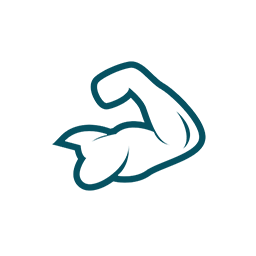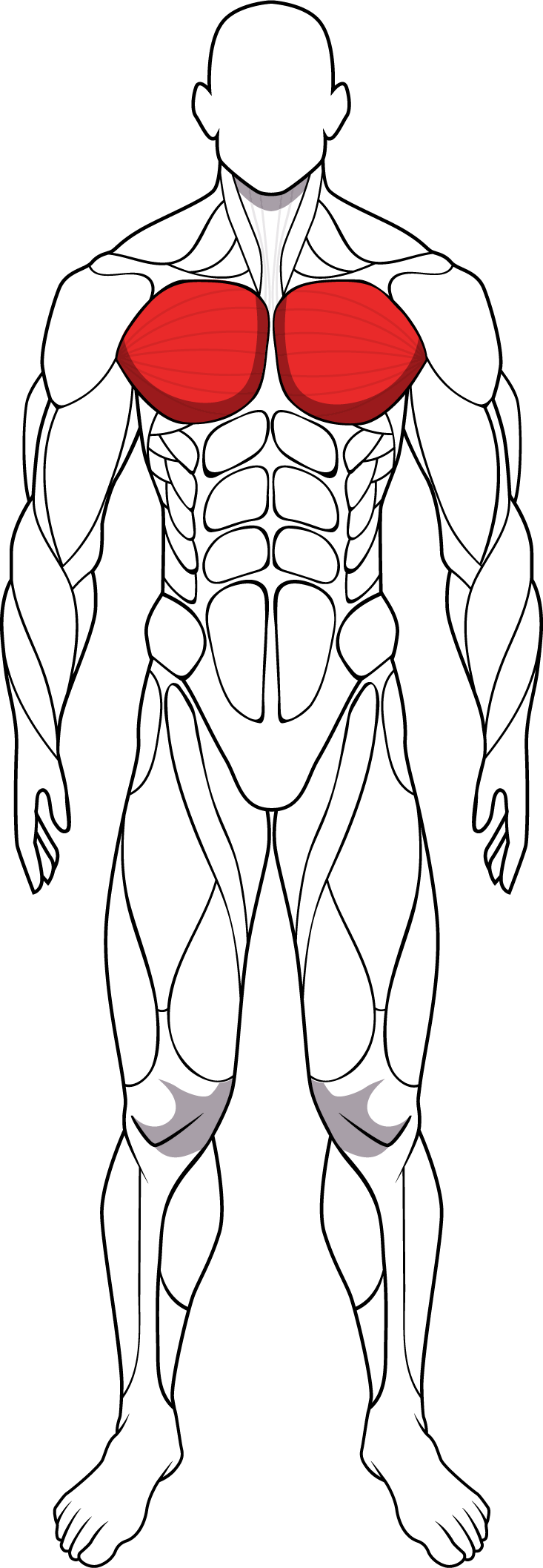The pectoralis major, commonly referred to as the pecs or chest muscles, is a large, fan-shaped muscle located in the chest region of the upper body. It plays a crucial role in various movements of the shoulder joint, particularly flexion, adduction, and medial rotation, as well as stabilizing the shoulder girdle during upper body exercises and activities.
The pectoralis major, commonly referred to as the pecs or chest muscles, is a large, fan-shaped muscle located in the chest region of the upper body. It plays a crucial role in various movements of the shoulder joint, particularly flexion, adduction, and medial rotation, as well as stabilizing the shoulder girdle during upper body exercises and activities.
The pectoralis major muscle has two primary heads:
Clavicular Head: The clavicular head of the pectoralis major is the upper portion of the muscle and originates from the anterior surface of the medial half of the clavicle (collarbone).
Sternal Head: The sternal head of the pectoralis major is the larger, lower portion of the muscle and originates from the sternum (breastbone), as well as the cartilage of the first six ribs and the aponeurosis of the external oblique muscle.
Both heads of the pectoralis major converge to form a single muscle belly that inserts into the intertubercular groove (bicipital groove) of the humerus (upper arm bone). This insertion point allows the pecs to exert force on the arm, facilitating movements such as shoulder flexion (raising the arm forward), shoulder adduction (bringing the arm across the body), and shoulder medial rotation (rotating the arm inward).
Functions of the pectoralis major muscle include:
Shoulder Flexion: The pectoralis major assists in flexing the shoulder joint, particularly when the arm is raised forward and upward. This movement is commonly involved in activities such as lifting objects overhead and performing pushing movements.
Shoulder Adduction: The pectoralis major is a powerful adductor of the shoulder joint, meaning it brings the arm closer to the midline of the body. This action is important for movements such as pressing exercises, pushing objects, and hugging.
Shoulder Medial Rotation: The pectoralis major contributes to medial rotation of the shoulder joint, particularly when the arm is at the side of the body. This movement is involved in actions such as throwing, swinging, and reaching across the body.
Stabilization of the Shoulder Girdle: In addition to its role in shoulder movement, the pectoralis major also helps stabilize the shoulder girdle during upper body exercises and activities, ensuring proper alignment and function of the shoulder joint.
Strengthening the pectoralis major muscles is important for improving upper body strength, stability, and aesthetics. Some common exercises that target the chest muscles include:
Bench Press: The bench press is a compound exercise that can be performed using a barbell, dumbbells, or a machine. It involves lying on a flat bench and pressing a weight upward from the chest to full arm extension, primarily targeting the pectoralis major, as well as the triceps and anterior deltoids.
Push-Ups: Push-ups are a bodyweight exercise that targets the chest, shoulders, and triceps. They involve starting in a plank position with the hands shoulder-width apart and lowering the chest toward the floor by bending the elbows, then pushing back up to the starting position.
Dumbbell Flyes: Dumbbell flyes are performed lying on a bench with a dumbbell in each hand. The arms are extended outward to the sides with a slight bend in the elbows, then brought back together in a hugging motion, targeting the chest muscles.
Chest Dips: Chest dips can be performed using parallel bars or a dip machine. They involve lowering the body by bending the elbows until the upper arms are parallel to the ground, then pushing back up to the starting position, targeting the chest and triceps.
Cable Crossovers: Cable crossovers are performed using a cable machine with handles attached to cables at high positions. They involve crossing the arms in front of the body while keeping a slight bend in the elbows, then returning to the starting position, targeting the chest muscles.
Incorporating a variety of these exercises into your workout routine can help develop strong, well-defined pectoralis major muscles, improve upper body strength and aesthetics, and enhance overall athletic performance. As with any exercise program, it's essential to perform movements with proper form and technique to maximize effectiveness and minimize the risk of injury. If you're new to strength training or have any concerns, consider working with a qualified fitness professional to develop a safe and effective workout plan tailored to your goals and fitness level.
The pectoralis major muscle has two primary heads:
Clavicular Head: The clavicular head of the pectoralis major is the upper portion of the muscle and originates from the anterior surface of the medial half of the clavicle (collarbone).
Sternal Head: The sternal head of the pectoralis major is the larger, lower portion of the muscle and originates from the sternum (breastbone), as well as the cartilage of the first six ribs and the aponeurosis of the external oblique muscle.
Both heads of the pectoralis major converge to form a single muscle belly that inserts into the intertubercular groove (bicipital groove) of the humerus (upper arm bone). This insertion point allows the pecs to exert force on the arm, facilitating movements such as shoulder flexion (raising the arm forward), shoulder adduction (bringing the arm across the body), and shoulder medial rotation (rotating the arm inward).
Functions of the pectoralis major muscle include:
Shoulder Flexion: The pectoralis major assists in flexing the shoulder joint, particularly when the arm is raised forward and upward. This movement is commonly involved in activities such as lifting objects overhead and performing pushing movements.
Shoulder Adduction: The pectoralis major is a powerful adductor of the shoulder joint, meaning it brings the arm closer to the midline of the body. This action is important for movements such as pressing exercises, pushing objects, and hugging.
Shoulder Medial Rotation: The pectoralis major contributes to medial rotation of the shoulder joint, particularly when the arm is at the side of the body. This movement is involved in actions such as throwing, swinging, and reaching across the body.
Stabilization of the Shoulder Girdle: In addition to its role in shoulder movement, the pectoralis major also helps stabilize the shoulder girdle during upper body exercises and activities, ensuring proper alignment and function of the shoulder joint.
Strengthening the pectoralis major muscles is important for improving upper body strength, stability, and aesthetics. Some common exercises that target the chest muscles include:
Bench Press: The bench press is a compound exercise that can be performed using a barbell, dumbbells, or a machine. It involves lying on a flat bench and pressing a weight upward from the chest to full arm extension, primarily targeting the pectoralis major, as well as the triceps and anterior deltoids.
Push-Ups: Push-ups are a bodyweight exercise that targets the chest, shoulders, and triceps. They involve starting in a plank position with the hands shoulder-width apart and lowering the chest toward the floor by bending the elbows, then pushing back up to the starting position.
Dumbbell Flyes: Dumbbell flyes are performed lying on a bench with a dumbbell in each hand. The arms are extended outward to the sides with a slight bend in the elbows, then brought back together in a hugging motion, targeting the chest muscles.
Chest Dips: Chest dips can be performed using parallel bars or a dip machine. They involve lowering the body by bending the elbows until the upper arms are parallel to the ground, then pushing back up to the starting position, targeting the chest and triceps.
Cable Crossovers: Cable crossovers are performed using a cable machine with handles attached to cables at high positions. They involve crossing the arms in front of the body while keeping a slight bend in the elbows, then returning to the starting position, targeting the chest muscles.
Incorporating a variety of these exercises into your workout routine can help develop strong, well-defined pectoralis major muscles, improve upper body strength and aesthetics, and enhance overall athletic performance. As with any exercise program, it's essential to perform movements with proper form and technique to maximize effectiveness and minimize the risk of injury. If you're new to strength training or have any concerns, consider working with a qualified fitness professional to develop a safe and effective workout plan tailored to your goals and fitness level.


